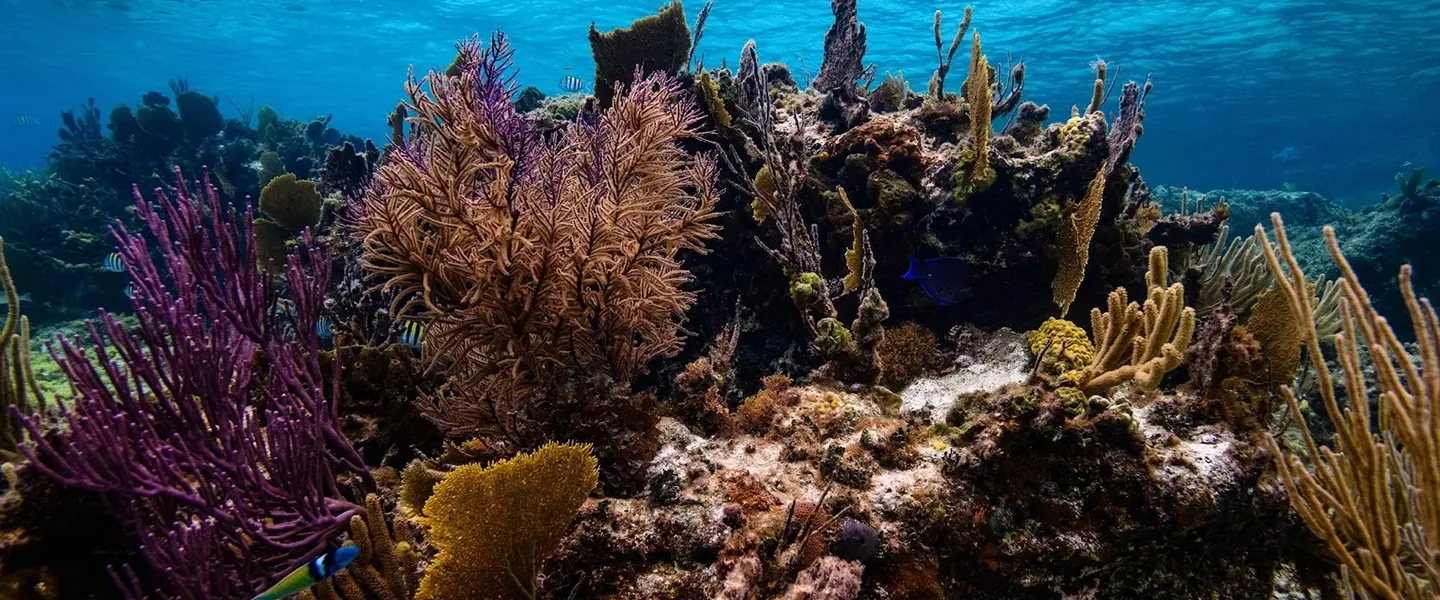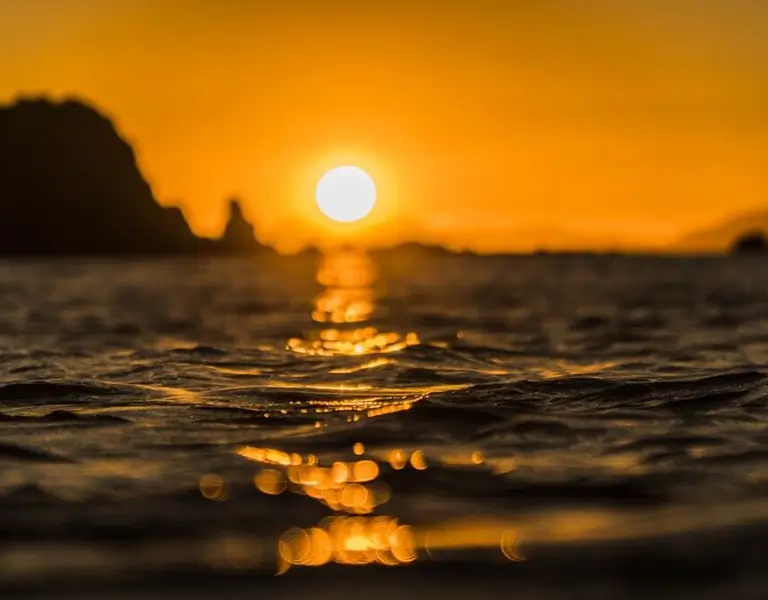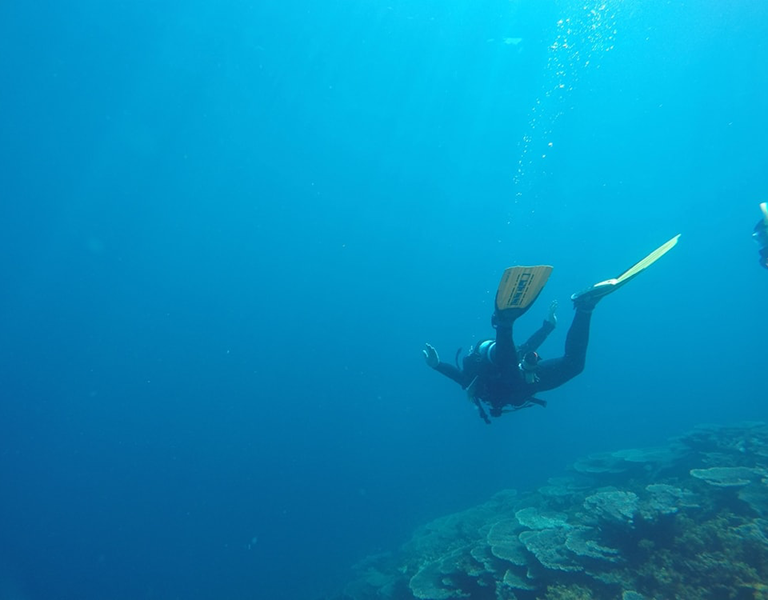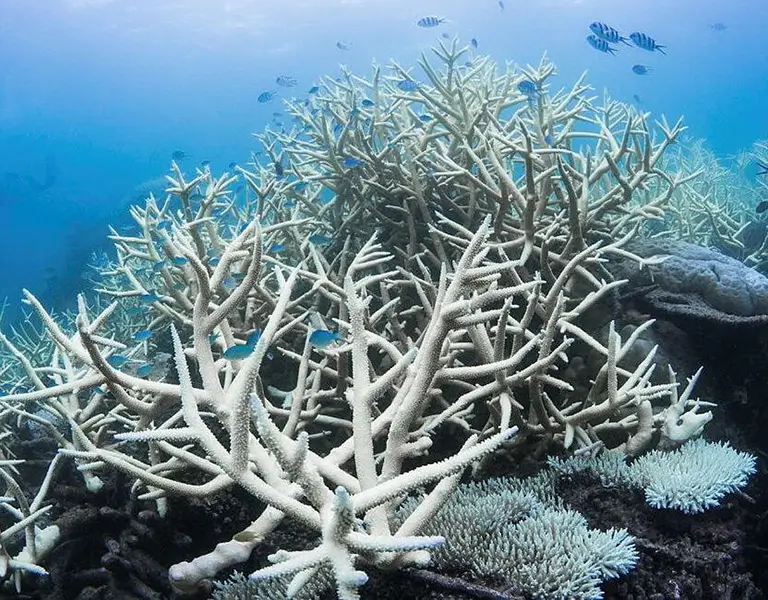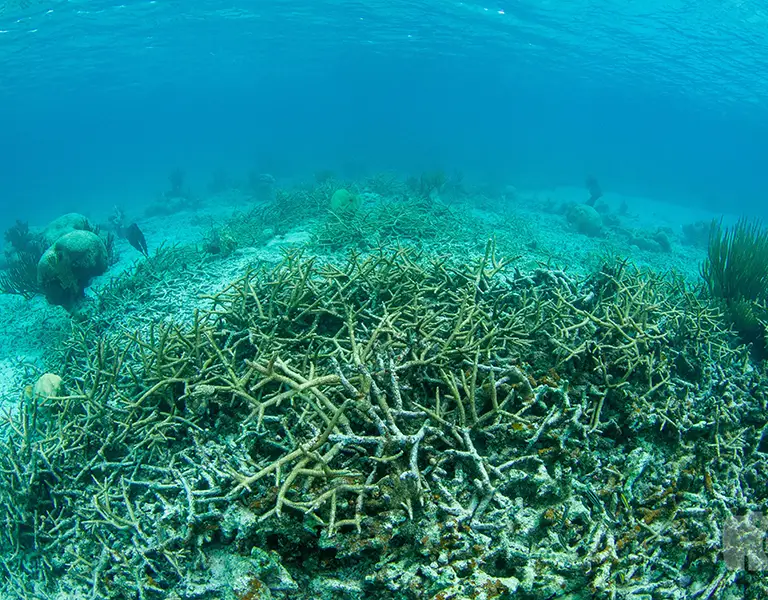Key Takeaways
This comprehensive guide explores the diverse plant communities that power coral reef ecosystems, their ecological importance, and the challenges they face in our changing world.
Key Takeaways
- Coral reef plants, particularly algae, are the foundation of reef ecosystems, producing oxygen and providing food for countless marine species.
- Despite their plant-like appearance, corals are actually animals that form symbiotic relationships with photosynthetic algae living inside their tissues.
- Marine plants, including algae and sea grasses, contribute significantly to coral reef biodiversity by creating habitats and stabilizing reef structures.
- Healthy plant communities are essential indicators of coral reef health and play a crucial role in the reef’s resilience against climate change impacts.
- Protecting coral reef plant communities is vital for preserving these underwater ecosystems that support both marine life and human communities worldwide.
Introduction to Coral Reef Plants
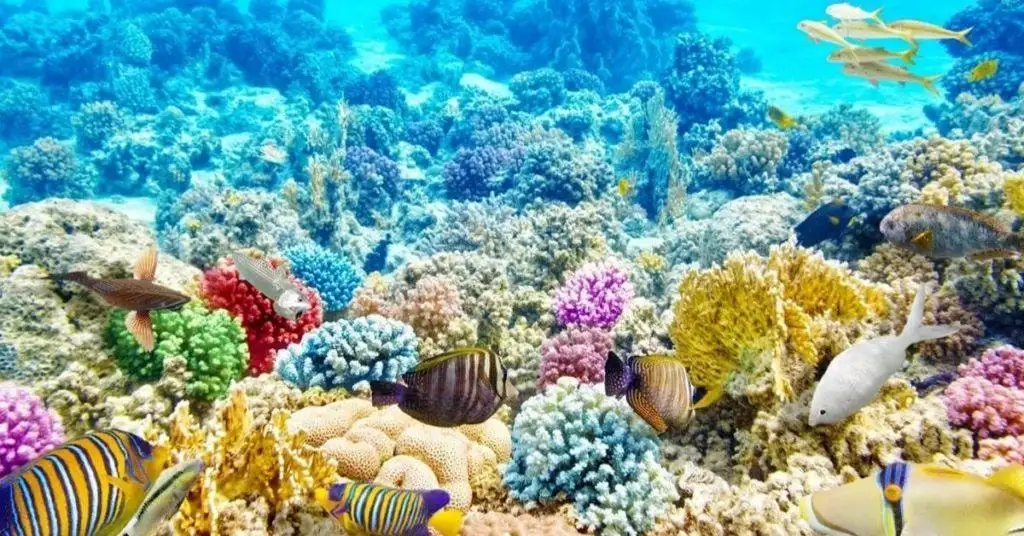
When we dive beneath the surface of tropical waters and witness the kaleidoscope of colors and shapes that make up a coral reef, we’re seeing one of Earth’s most remarkable and complex ecosystems in action. While the vibrant coral colonies might steal the spotlight, it’s the diverse community of plants and plant-like organisms that form the foundation of these underwater marvels.
The relationship between plants and coral reefs is both fascinating and fundamental to the health of our oceans. From microscopic algae that fuel the growth of reef-building corals to the swaying meadows of sea grass that stabilize coastal sediments, plants are the unsung heroes of reef ecosystems. They capture energy from the sun, produce oxygen, provide food and habitat for countless marine creatures, and help maintain the delicate balance that allows coral reefs to thrive.
In this article, we’ll explore the diverse world of coral reef plants, uncovering their ecological importance, the challenges they face in our changing climate, and why their protection is essential for the future of our oceans. By understanding the role of plants in coral reef ecosystems, we gain valuable insights into how these remarkable underwater communities function—and how we might better protect them for generations to come.
Coral Reef Ecosystems: Nature’s Underwater Cities
Coral reefs are often called the “rainforests of the sea” for good reason. These underwater ecosystems cover less than 1% of the ocean floor yet support approximately 25% of all marine species.[1] The backbone of these vibrant communities are the reef-building corals themselves, which create the complex three-dimensional structures that provide habitat for thousands of species of fish, invertebrates, and plants.
What many people don’t realize is that despite their plant-like appearance, corals are actually invertebrate animals. Each coral colony consists of thousands of tiny individual animals called polyps. These polyps secrete calcium carbonate skeletons that form the foundation of the reef structure. However, the relationship between corals and plants is where the true magic happens.
Reef-building corals rely on a remarkable symbiotic relationship with microscopic algae called zooxanthellae that live within their tissues. These algae photosynthesize and provide the coral with up to 90% of its energy needs while receiving protection and access to sunlight in return.[2] This plant-animal partnership is the key to coral reefs’ ability to thrive in nutrient-poor tropical waters and build massive reef structures over time.
Coral reef ecosystems come in various forms, each with unique characteristics:
Fringing reefs grow close to shorelines and are common around volcanic islands. Their proximity to land means they often feature different plant communities than reefs further offshore.
Barrier reefs run parallel to coastlines but are separated from land by lagoons. Australia’s Great Barrier Reef is the world’s largest example, stretching over 1,400 miles and supporting countless species of marine plants and algae.
Atolls are circular or oval reefs surrounding a central lagoon, formed when islands sink and corals continue to grow upward. These isolated reef systems often develop unique plant communities adapted to their specific conditions.
Patch reefs are smaller, isolated reef formations that grow up from the ocean floor, often within lagoons or between fringing and barrier reefs. These “reef islands” create diverse habitats for specialized plant communities.
The physical structure created by reef-building corals provides countless microhabitats for plants to colonize. From the bright, wave-washed reef crest to shadowy crevices and calm lagoons, each zone supports different plant species adapted to its unique conditions. This habitat diversity is one reason coral reefs are among the most biologically diverse ecosystems on Earth.
The Surprising Truth About Coral Reef Plants
When we think about plants in coral reefs, there’s an important distinction to make right away: most of what appears to be “plants” in coral reef environments are actually algae, which are not true plants but photosynthetic organisms from several different biological kingdoms. True plants found in reef ecosystems include sea grasses, which are flowering plants that evolved from land plants and returned to the sea.
This distinction matters because algae and plants play different ecological roles in reef ecosystems, though both are vital components. Here’s how the major groups break down:
Marine Algae: The Colorful Foundation
Marine algae are incredibly diverse and fall into several major groups distinguished by their photosynthetic pigments, which give them their characteristic colors:
Green algae (Chlorophyta) are among the most plant-like algae and are believed to share a common ancestor with land plants. In coral reefs, green algae common species include sea lettuce (Ulva sp.) and the grape-like Caulerpa species. These algae thrive in shallow reef areas where sunlight is abundant and contribute significantly to primary production in the ecosystem.
Red algae (Rhodophyta) contain distinctive photosynthetic pigments specialized for capturing light at greater depths than other algae. Some red algae, known as coralline algae, incorporate calcium carbonate into their cell walls, creating hard structures that contribute to reef building and help cement coral fragments together. These pink to purple crusts are crucial for reef structure and stability.
Brown algae (Phaeophyta) include larger seaweeds with complex structures. While less common on tropical reefs than in temperate waters, certain species can be found creating habitat complexity and providing food for herbivorous reef fish and sea urchins.
Turf algae are assemblages of short, filamentous algae that form carpet-like growths over reef surfaces. These mixed communities are important primary producers but can overgrow and smother corals if not kept in check by herbivores.
True Plants in Coral Reef Environments
Sea grasses are flowering plants that evolved from terrestrial ancestors and returned to the marine environment. Unlike algae, they have true roots, stems, leaves, and produce flowers and seeds. Sea grass beds often develop in sandy areas adjacent to reefs or in reef lagoons. These underwater meadows stabilize sediments, provide nursery habitat for reef fish, and sequester carbon dioxide effectively.
Mangroves are not reef plants per se, but these specialized salt filtering roots trees form crucial interconnected ecosystems with coral reefs in many tropical locations. Mangrove forests protect coastlines from erosion, filter terrestrial runoff before it reaches reefs, and provide nursery habitat for many reef fish species.
The distinction between algae and true plants is more than just biological classification—it reflects different evolutionary strategies for survival in marine environments. Both contribute to the remarkable biodiversity that makes coral reef ecosystems so valuable and worthy of protection.
Microscopic Algae: The Invisible Engine of Coral Reefs

At the foundation of coral reef ecosystems, too small to see with the naked eye but enormous in ecological importance, are the microscopic algae that power reef productivity. These tiny photosynthetic organisms fall into several categories, each playing a crucial role in reef health and function.
Zooxanthellae: The Coral’s Life Partners
Perhaps the most important microscopic algae in coral reef ecosystems are zooxanthellae, the single-celled dinoflagellates that live within coral tissues. This extraordinary symbiotic relationship is the cornerstone of reef existence:
- Zooxanthellae photosynthesize using sunlight that penetrates the clear, shallow waters where coral reefs thrive
- They provide their coral hosts with up to 90% of their energy requirements in the form of glucose, glycerol, and amino acids
- In return, corals provide zooxanthellae with protection and access to sunlight, plus compounds needed for photosynthesis
This partnership allows corals to thrive in nutrient-poor tropical waters and deposit calcium carbonate skeletons that build massive reef structures over time. When corals become stressed—particularly from elevated ocean temperatures—they may expel their zooxanthellae, leading to coral bleaching. If this condition persists, the corals will starve and die, highlighting how crucial this plant-animal relationship is to reef survival.
Phytoplankton: Drifting Microscopic Forests
Phytoplankton are microscopic, free-floating algae that conduct photosynthesis in the water column. While less abundant in the clear waters surrounding healthy reefs than in other marine environments, they still play important roles:
- Contribute to the food web by serving as food for zooplankton, which in turn feed many reef creatures
- Help cycle nutrients in reef ecosystems
- Generate oxygen through photosynthesis
The balance of phytoplankton around reefs is delicate—too few means insufficient food resources for certain species, while too many (often caused by excess nutrients from pollution) can reduce water clarity and harm corals by blocking essential sunlight.
Cyanobacteria: Ancient Reef Builders
Cyanobacteria, sometimes called blue-green algae (though they’re actually bacteria), were among Earth’s first photosynthetic organisms and ancient reef builders. In modern reefs, they:
- Fix nitrogen from the atmosphere, making this essential nutrient available to other reef organisms
- Form mats that can stabilize sediments in certain reef zones
- In some cases, form symbiotic relationships with sponges and other reef invertebrates
However, when environmental conditions change—particularly with increased nutrients from pollution—cyanobacteria can bloom excessively, smothering corals and producing toxins harmful to reef life. Monitoring cyanobacteria populations can provide early warnings about declining reef health.
These microscopic photosynthesizers might be invisible to casual observation, but their combined productivity forms the energetic foundation upon which the entire reef ecosystem depends. Their health directly influences coral growth, reef structure, and the abundance of fish and invertebrates that make reefs such spectacular underwater communities.
Macroalgae: The Visible Plants of Coral Reefs
While microscopic algae provide the energy foundation for coral reefs, it’s the larger macroalgae that create much of the visible “plant life” divers and snorkelers observe. These diverse and colorful organisms contribute significantly to reef biodiversity, structure, and function.
Green Algae: The Emerald Engineers
Green algae are among the most recognizable macroalgae on coral reefs, sporting vibrant green hues thanks to their chlorophyll content—similar to land plants. Some notable varieties include:
Sea grapes (Caulerpa species) feature distinctive grape-like vesicles and sprawling stolons that can create extensive green carpets across rocky reef surfaces. While aesthetically pleasing, some Caulerpa species can become invasive when introduced to new areas, outcompeting native species.
Sea lettuce (Ulva species) grows in thin, crinkly sheets that wave gracefully with water movement. These fast-growing algae are important food sources for many herbivorous fish and sea urchins on the reef.
Halimeda species incorporate calcium carbonate into their tissues, contributing to reef sediments when they die. These segmented algae can form meadows in sandy areas and contribute significantly to the white sand beaches that often accompany coral reef systems.
Green algae tend to flourish in shallow reef areas with abundant sunlight and play important roles in nutrient cycling, particularly nitrogen and phosphorus, which are often limited in tropical reef environments.
Red Algae: The Deep Specialists
Red algae contain specialized pigments that allow them to photosynthesize at greater depths than other algae, giving them a competitive advantage in areas of the reef where light is more limited. Their ecological contributions include:
Coralline algae are perhaps the most important red algae on reefs. These hard, pink to purple crusts incorporate calcium carbonate into their cell walls, cementing loose coral fragments together and contributing to reef structure. Research has shown that the presence of coralline algae can actually trigger coral larval settlement, making them critical for reef recovery after disturbances.[3]1
Gelatinous red algae species create complex three-dimensional habitats that shelter small invertebrates and juvenile fish, adding to reef biodiversity and resilience.
Red algae species often contain compounds that deter grazing, allowing them to persist even in areas with abundant herbivores. Some of these compounds are being studied for potential medical applications, including antimicrobial and anti-cancer properties.
Brown Algae: The Reef’s Seaweeds
Brown algae include some of the larger, more structurally complex “seaweeds” found in reef environments. While more diverse and abundant in temperate waters, several species make important contributions to tropical reef ecosystems:
Sargassum species can form floating mats that provide habitat for a unique community of marine organisms, creating connections between different reef systems through their drift.
Padina species have distinctive fan-shaped growth forms with concentric rings and a whitish appearance due to light calcium carbonate deposits.
Turbinaria species feature tough, leathery textures with distinctive triangular blades arranged around a central axis, allowing them to withstand strong wave action on reef crests.
Brown algae often contain alginates and other compounds that have commercial value for food products, pharmaceuticals, and industrial applications.
The balance between macroalgae and corals is a key indicator of reef health. While diverse macroalgae communities contribute to healthy reef ecosystems, shifts toward algal dominance—often caused by overfishing of herbivores, nutrient pollution, or coral mortality—can signal a reef in decline. Maintaining this balance through ecosystem management and protection is essential for coral reef conservation.
Sea Grasses: The Flowering Meadows of the Reef
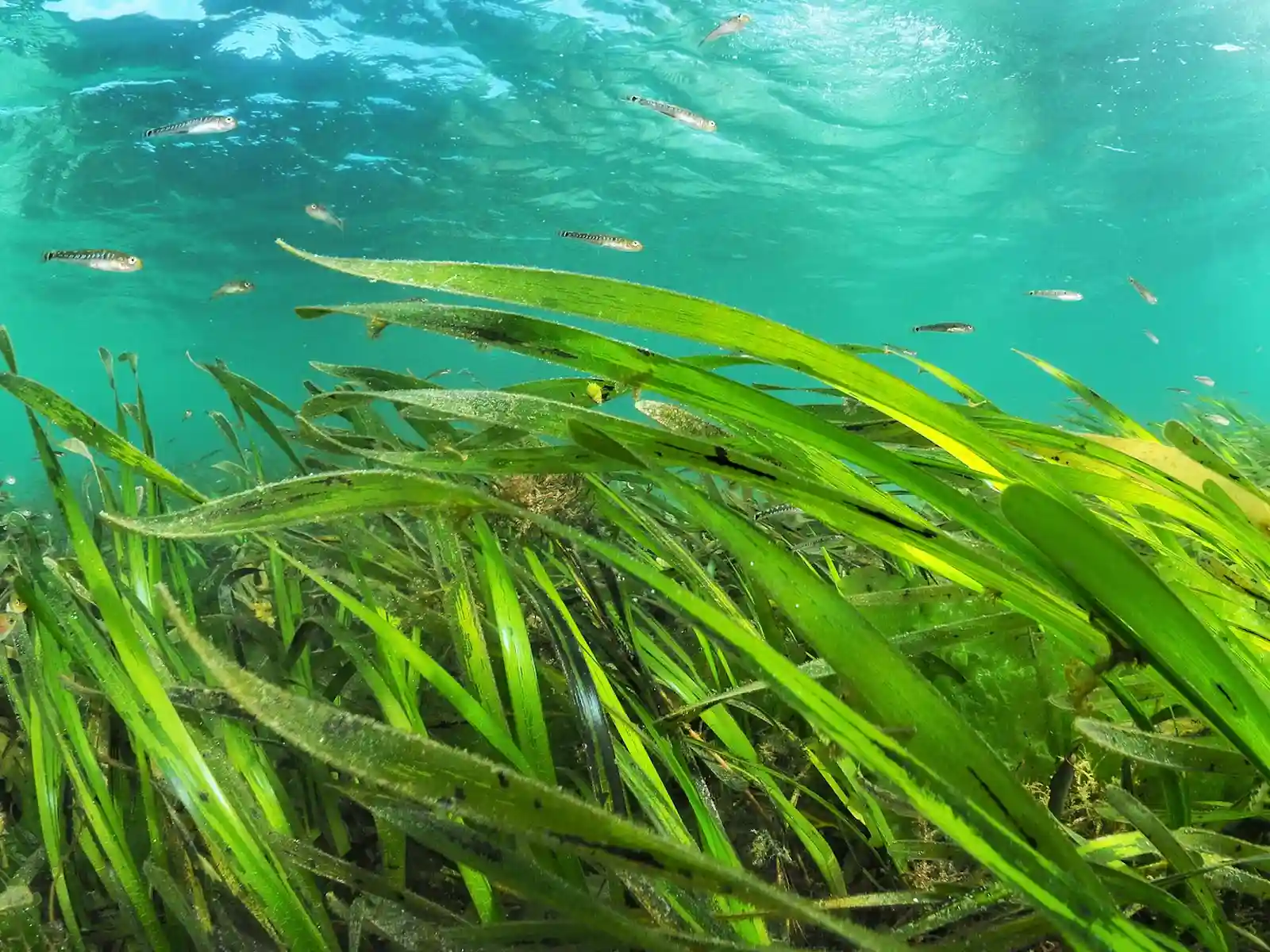
Among the true plants associated with coral reef ecosystems, sea grasses stand out as remarkable examples of evolutionary adaptation. Unlike algae, sea grasses are flowering plants (angiosperms) that returned to the marine environment millions of years ago, developing specialized adaptations for underwater life while retaining characteristics of their terrestrial ancestors.
The Unique Nature of Sea Grasses
Sea grasses represent one of only a few groups of flowering plants that have successfully colonized marine environments. Their distinctive features include:
- True roots, stems, and leaves (unlike algae)
- The ability to flower and produce seeds underwater
- Specialized salt filtering roots systems that allow them to tolerate saltwater
- Internal air channels that transport oxygen to roots in oxygen-poor sediments
- Strong, flexible structures that withstand wave action and tidal movements
Common sea grass species found in association with coral reefs include turtle grass (Thalassia testudinum), manatee grass (Syringodium filiforme), and shoal grass (Halodule wrightii). These plants typically grow in sandy or muddy substrates in reef lagoons, back reef areas, or on the continental shelf adjacent to reef systems.
Ecological Functions of Sea Grass Beds
Sea grass meadows perform several crucial functions that benefit coral reef ecosystems:
Habitat provision: Sea grass beds create structural complexity that serves as nursery habitat for juvenile reef fish and invertebrates. Many commercially important reef fish species spend their early life stages in sea grass before moving to the reef as adults.
Sediment stabilization: The extensive root systems of sea grasses bind sediments, preventing erosion and helping maintain water clarity—critical for the photosynthetic processes that sustain both sea grasses and corals.
Nutrient cycling: Sea grasses efficiently absorb and incorporate nutrients from the water column and sediments, helping prevent excessive nutrient levels that could harm coral reef systems.
Carbon sequestration: Sea grass meadows are among the most effective carbon sinks in the marine environment, storing carbon in both their tissues and the sediments they stabilize, helping mitigate climate change impacts.
Food for herbivores: Sea grasses provide direct nutrition for specialized grazers like green sea turtles and manatees, as well as some reef fish species that move between reef and sea grass habitats.
The Sea Grass-Coral Reef Connection
The relationship between sea grass beds and coral reefs exemplifies the interconnected nature of marine ecosystems. These distinct but linked habitats benefit each other in several ways:
- Sea grass beds filter terrestrial runoff, reducing sedimentation and nutrient impacts on nearby reefs
- The protected waters of reef systems create low-energy environments where sea grasses can flourish
- Many marine species migrate between these habitats during different life stages or for feeding
- Both ecosystems provide coastal protection, working together to dissipate wave energy
Unfortunately, like coral reefs, sea grass meadows face numerous threats from human activities, including coastal development, water pollution, mechanical damage from boats, and climate change impacts. Their decline can have cascading effects on associated reef systems, highlighting the importance of protecting these interconnected marine habitats.
Research suggests that conservation efforts targeting both coral reefs and associated sea grass beds yield greater overall ecological benefits than focusing on either system in isolation.[4] This ecosystem-based approach to marine conservation recognizes the fundamental connections between these different but complementary underwater communities.
Reef Algae: A Delicate Balance
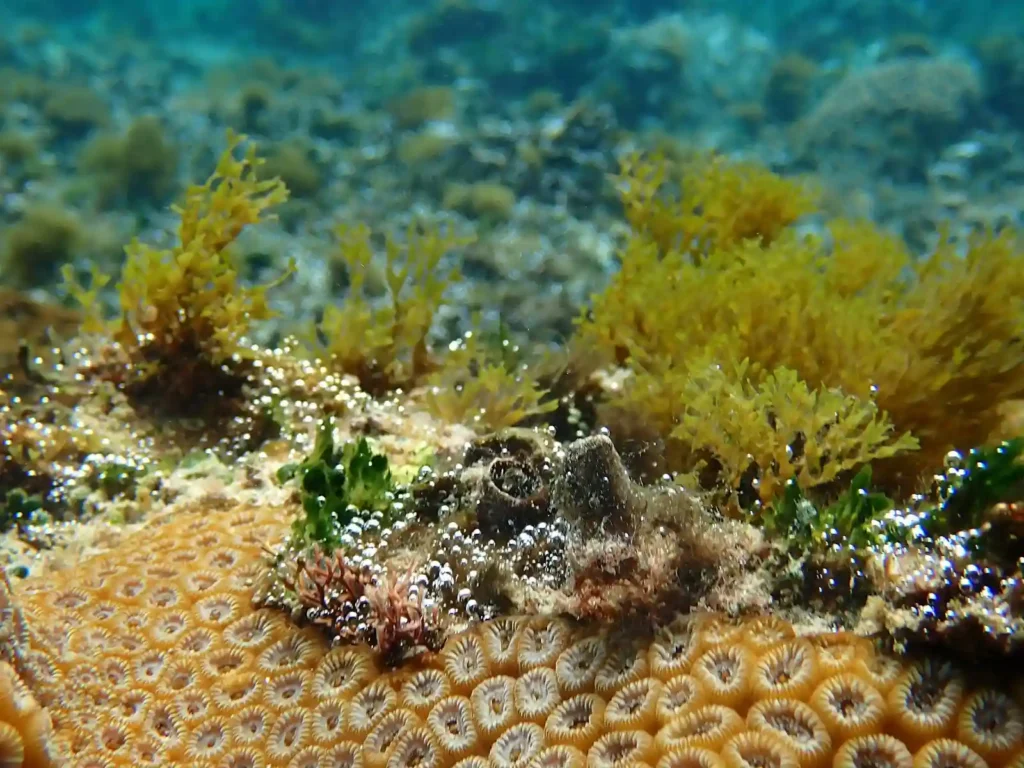
The relationship between algae and corals on a reef is a study in ecological balance. While algae are vital components of healthy reef ecosystems, their abundance relative to corals serves as a key indicator of reef condition. Understanding this balance is essential for reef conservation and restoration efforts.
The Role of Algae in Healthy Reefs
In thriving reef ecosystems, diverse algae communities contribute positively in numerous ways:
Primary production: Algae capture energy from sunlight through photosynthesis, forming the base of the reef food web and generating oxygen that benefits all reef inhabitants.
Habitat creation: Many macroalgae species provide structural complexity that shelters small invertebrates and juvenile fish, enhancing biodiversity.
Reef building: Coralline algae cement loose reef fragments together and provide chemical cues that encourage coral larval settlement.
Food provision: Different algae species feed everything from tiny invertebrates to large herbivorous fish and sea urchins, supporting diverse food webs.
A healthy reef typically features diverse algal communities kept in check by abundant herbivores, with corals dominating the hard substrate. The precise balance varies naturally with depth, wave exposure, and geographical location.
When Balance Shifts: Algal Dominance
When reefs experience disturbances—whether from pollution, overfishing, climate impacts, or other stressors—the coral-algae balance can shift dramatically. Several factors can promote excessive algal growth:
Nutrient enrichment: Runoff containing fertilizers, sewage, or other nutrient sources can stimulate rapid algal growth, similar to how fertilizer affects land plants.
Herbivore depletion: Overfishing of grazing fish or die-offs of sea urchins remove the natural controls on algal populations, allowing them to grow unchecked.
Coral mortality: When corals die from bleaching, disease, or other causes, they leave behind substrate that algae can quickly colonize.
This shift from coral to algal dominance—often called a “phase shift”—can be difficult to reverse once established. Dense algal growth can prevent coral larvae from settling, create sediment traps, reduce water flow, and deplete oxygen levels at night, creating conditions that further disadvantage corals.
Managing the Balance
Conservation and restoration efforts increasingly focus on maintaining or restoring the healthy coral-algae balance through several approaches:
Protecting herbivores: Establishing marine protected areas that prohibit fishing of key herbivorous species helps maintain natural algae control mechanisms.
Nutrient management: Improving shoreline management, wastewater treatment, and agricultural practices reduces nutrient inputs that fuel excessive algal growth.
Coral restoration: Active restoration efforts, including coral farming and outplanting, help reestablish coral cover in degraded areas.
Algae removal: In some cases, direct intervention to remove excessive algae growth can help create space for coral recruitment and growth.
Understanding the complex dynamics between corals and algae helps reef managers develop effective conservation strategies. Rather than viewing algae as simply “good” or “bad,” modern reef management recognizes the importance of appropriate algal diversity and abundance within the broader ecological context of coral reef ecosystems.
Mangrove Forests: Guardians of the Reef

While not growing directly on coral reefs, mangrove forests form a crucial connected ecosystem that protects and sustains reef environments. These remarkable trees, adapted to the challenging interface between land and sea, provide numerous benefits to coral reef systems.
The Mangrove-Reef Connection
Mangrove forests typically grow along tropical and subtropical coastlines, often in proximity to coral reefs. This proximity is no coincidence—these ecosystems have co-evolved and developed important functional linkages:
Sediment filtering: Mangrove roots trap terrestrial sediments that would otherwise smother coral reefs. Their complex root systems act as natural filters, improving water quality reaching offshore reef systems.
Nutrient management: Mangroves absorb excess nutrients from land runoff that might otherwise cause algal blooms and harm coral reefs. This filtering function is increasingly important as coastal development intensifies.
Nursery habitat: Many reef fish species use mangrove forests as nursery grounds during juvenile stages before migrating to coral reefs as adults. These include commercially and ecologically important species like snappers, groupers, and parrotfish.
Carbon sequestration: Mangroves are among the most carbon-rich forests in the tropics, sequestering carbon in both living biomass and sediments, helping mitigate climate impacts that threaten reefs.
Storm buffering: Mangrove forests reduce wave energy and storm surge impacts on coastlines, helping protect both coastal communities and nearshore coral reef structures.
Mangrove Species Diversity
Mangrove ecosystems feature specialized tree species with remarkable adaptations for survival in saline, waterlogged conditions:
Red mangroves (Rhizophora species) are often found closest to the water’s edge, recognizable by their distinctive prop roots that arch from the trunk into the water and sediment.
Black mangroves (Avicennia species) typically grow more inland, featuring pneumatophores—specialized aerial roots that project upward from the sediment to access oxygen.
White mangroves (Laguncularia racemosa) usually occupy the highest ground in mangrove forests, with less specialized root adaptations.
Buttonwood (Conocarpus erectus) often grows at the landward edge of mangrove ecosystems, transitioning to terrestrial environments.
These different species create zones from the water’s edge inland, each providing distinct habitat characteristics and ecological functions that support the overall reef-mangrove system.
Conservation Challenges and Opportunities
Despite their ecological importance, mangrove forests face severe threats globally:
- Clearance for coastal development, including tourism infrastructure
- Conversion to aquaculture, particularly shrimp farming
- Harvesting for timber, fuel, and charcoal
- Pollution from agricultural and industrial sources
- Sea level rise threatening their habitat range
The loss of mangrove forests has direct implications for coral reef health, highlighting the importance of integrated conservation approaches that recognize the connectivity between these ecosystems. Encouragingly, mangrove restoration has proven relatively successful in many regions, offering opportunities to rebuild these protective barriers around coral reef systems.
Innovative conservation approaches increasingly focus on “ridge-to-reef” management that considers entire watersheds and connected ecosystems rather than treating coral reefs in isolation. This holistic approach recognizes that protecting mangroves is often one of the most cost-effective strategies for supporting coral reef resilience in the face of climate change and other anthropogenic stressors.
Saving the Ocean’s Rainforests: The Importance of Reef Plant Conservation
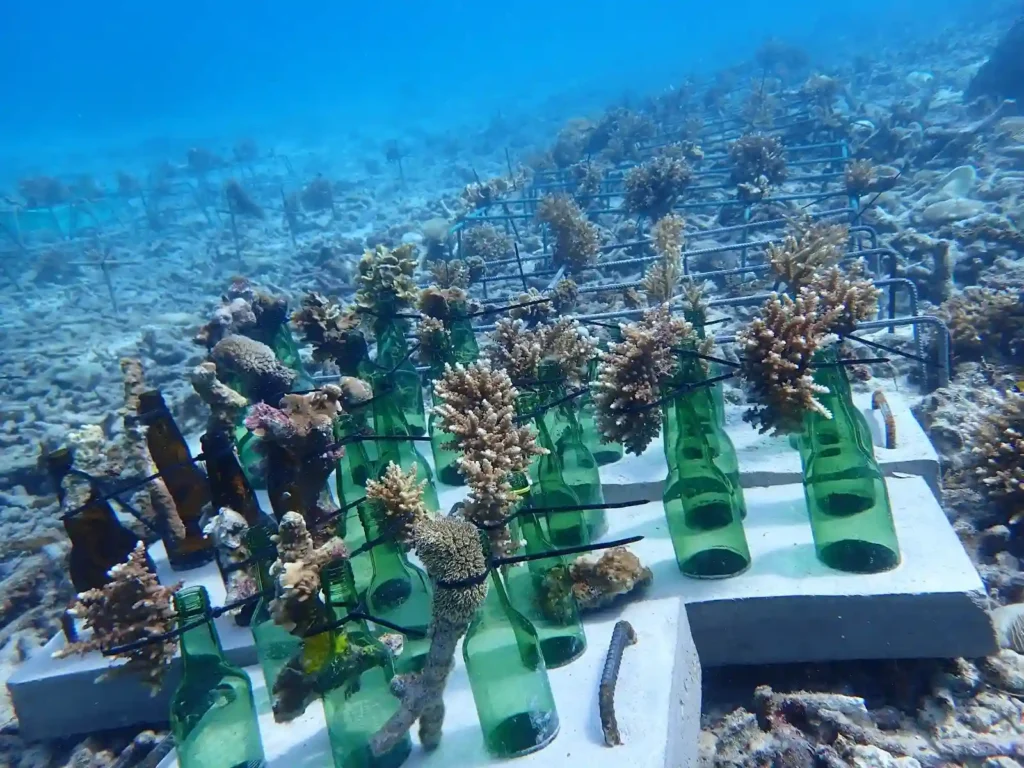
The diverse plant communities of coral reef ecosystems—from microscopic zooxanthellae to towering mangroves—face unprecedented challenges in today’s rapidly changing world. Understanding these threats and the approaches to address them is crucial for preserving these underwater forests for future generations.
Threats to Coral Reef Plant Communities
Coral reef plants and plant-like organisms face multiple interconnected threats:
Climate change impacts: Rising ocean temperatures cause coral bleaching (the expulsion of zooxanthellae) and can alter the distribution and composition of algal communities. Ocean acidification affects calcifying algae and makes it harder for coralline species to build their calcium carbonate structures.
Water quality degradation: Agricultural runoff, sewage discharge, and urban pollution introduce excess nutrients and sediments that can trigger harmful algal blooms, reduce water clarity, and smother benthic plants.
Physical damage: Destructive fishing practices, boat anchoring, and trampling by recreational users can directly damage macroalgae, sea grasses, and the corals that host zooxanthellae.
Invasive species: Non-native algae and plants can outcompete native species, disrupting ecological balances that have evolved over millennia.
Habitat loss: Coastal development destroys mangrove forests and sea grass beds that support reef ecosystems, while coral death from various stressors reduces habitat for specialized reef algae.
These threats rarely occur in isolation—their interactions often produce compound effects more severe than any single factor alone, creating complex conservation challenges.
Conservation and Restoration Approaches
Protecting and restoring coral reef plant communities requires multifaceted approaches:
Marine protected areas (MPAs): Well-designed and effectively managed MPAs can protect entire reef ecosystems, including their plant components, from direct human impacts while supporting resilience to climate change.
Watershed management: Addressing land-based sources of pollution and sedimentation helps maintain water quality conditions that support healthy reef plant communities.
Climate action: Both mitigation (reducing greenhouse gas emissions) and adaptation (supporting ecosystem resilience) strategies are essential for preserving the conditions reef plants need to survive.
Restoration initiatives: Active restoration of sea grass beds, mangrove forests, and coral reefs can help recover ecosystem functions and promote the return of diverse plant communities.[5]2
Sustainable fisheries management: Maintaining healthy populations of herbivorous fish helps prevent algal overgrowth and supports appropriate balance between corals and algae.
These approaches are most effective when implemented as part of integrated coastal management strategies that recognize the interconnections between mangroves, sea grasses, and coral reefs.
The Role of Research and Innovation
Scientific research continues to deepen our understanding of reef plant ecology and develop innovative conservation tools:
- Identifying coral species and strains with more temperature-tolerant zooxanthellae
- Developing methods to restore calcifying algae that contribute to reef structure
- Mapping connectivity between mangroves, sea grasses, and reefs to prioritize protection
- Testing nature-based solutions that enhance coastal protection while supporting plant communities
- Using remote sensing to monitor plant health and distribution across reef ecosystems
These research efforts inform evidence-based conservation decisions that maximize benefits for reef ecosystems and the communities that depend on them.
By protecting the diverse plant communities of coral reefs, we preserve not just individual species but the complex ecological interactions that make these underwater rainforests among the most productive and biodiversity-rich ecosystems on our planet. Their conservation requires both global action on climate change and local efforts to reduce direct impacts—a challenge that calls for unprecedented cooperation across disciplines, sectors, and national boundaries.
Rare Terrestrial Plants in Reef Environments
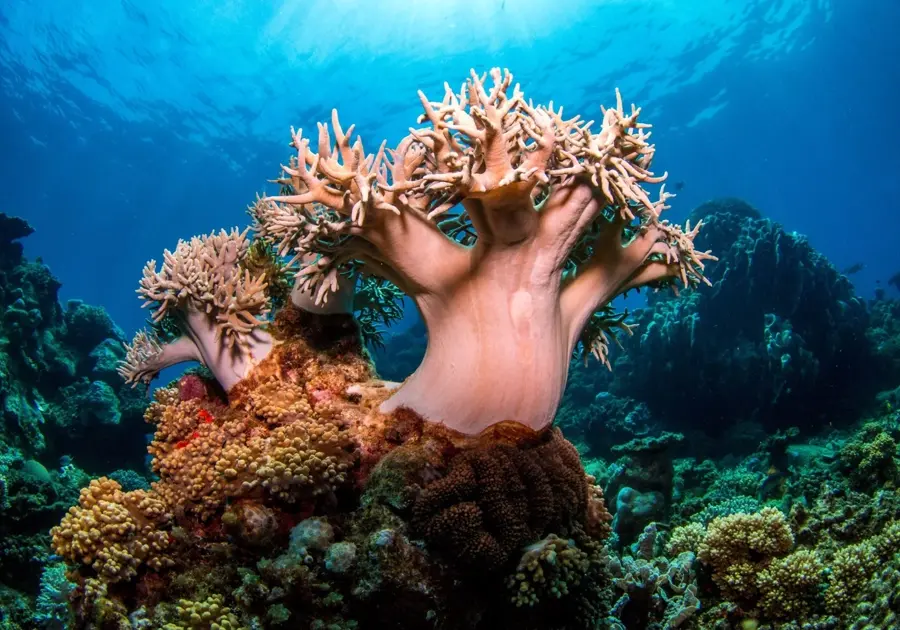
While coral reefs are underwater ecosystems dominated by marine life, certain tropical island and coastal settings create unique situations where terrestrial plants interact with reef environments. These specialized plant communities occupy a fascinating ecological niche at the interface between land and sea.
Small Islands and Coral Cays
Coral cays are small islands formed entirely from reef-derived sediments that accumulate on reef flats. These low-lying islands represent harsh environments for terrestrial plants due to several challenging factors:
- Limited freshwater availability
- High salinity from sea spray
- Strong winds and occasional storm impacts
- Restricted soil development
- Limited species availability for colonization
Despite these challenges, specialized plant communities develop on these islands, often following predictable succession patterns as the islands mature. Pioneer species like beach morning glory (Ipomoea pes-caprae) and sea purslane (Sesuvium portulacastrum) can tolerate the harsh conditions of newly formed islands, gradually improving soil conditions for later-arriving species.
The plants that successfully establish on coral cays often display specialized adaptations:
- Salt tolerance mechanisms
- Water conservation strategies
- Wind resistance features
- Effective seed dispersal via ocean currents or birds
- Ability to grow in nutrient-poor, sandy substrates
These rare terrestrial plant communities contribute to island stability, preventing erosion and creating microhabitats that support other organisms, including seabirds that connect island and reef ecosystems through their feeding and nesting behaviors.
Rocky Reef Surfaces and Limestone Terraces
In some locations, raised limestone terraces formed from ancient reefs create specialized habitats for terrestrial plants directly adjacent to active reef systems. These limestone environments present unique challenges:
- Limited soil development in rock crevices
- Rapid drainage leading to drought conditions
- Exposure to salt spray and storm impacts
- Alkaline substrate chemistry from calcium carbonate
Plant communities in these settings often include specialized limestone-adapted species with remarkable drought tolerance and the ability to extract nutrients from seemingly barren rocky substrates. Many develop extensive root systems that penetrate deep into rock fissures in search of water and nutrients.
These rocky coastal plant communities can include rare endemic species that have evolved in isolation on particular islands or coastlines. Their proximity to reef environments means they often play important roles in coastal protection, reducing erosion and filtering terrestrial runoff before it reaches the reef.
Conservation Significance
The terrestrial plants associated with reef environments often receive less attention than their marine counterparts but face significant conservation challenges:
- Coastal development for tourism infrastructure frequently targets precisely the same beachfront areas these plants occupy
- Rising sea levels threaten to inundate low-lying coral cays and their specialized plant communities
- Invasive species can rapidly transform island vegetation, displacing native specialists
- Climate change may alter precipitation patterns, further challenging plants already living at the limits of water availability
Conserving these specialized terrestrial plant communities requires integrated approaches that consider entire island ecosystems and their connection to adjacent reef systems. Their protection not only preserves unique botanical diversity but also maintains important ecological functions that benefit the reef itself.
Research into these plant communities has practical applications beyond conservation, including coastal stabilization techniques, models for agriculture in challenging environments, and potential discoveries of novel compounds with pharmaceutical applications. These overlooked plant communities represent yet another facet of the remarkable biodiversity associated with coral reef ecosystems.
The Future of Coral Reef Plants
As we look toward the future of coral reef ecosystems, the plant communities that sustain them face both unprecedented challenges and promising opportunities. Understanding these dynamics is essential for developing effective conservation strategies that ensure these underwater rainforests continue to thrive.
Adapting to a Changing Ocean
Climate change represents perhaps the greatest challenge to reef plant communities, manifesting through several mechanisms:
Rising temperatures affect the delicate relationship between corals and their zooxanthellae, potentially triggering mass bleaching events. However, research suggests some algal symbionts show greater heat tolerance, potentially allowing for adaptation over time.
Ocean acidification3 threatens calcifying plants like coralline algae that incorporate calcium carbonate into their structures. Yet some species may have more capacity to maintain calcification under acidified conditions than previously thought.
Changing current patterns may alter larval dispersal and nutrient distribution, reshaping plant community composition across reef systems. These shifts could create both winners and losers among reef plant species.
While these challenges are daunting, emerging research suggests some reef plants may have more adaptive capacity than initially feared. Evolution operates even on ecological timescales, and some species are showing signs of acclimatization to changing conditions. The key question is whether adaptation can keep pace with the unprecedented rate of anthropogenic change.
Innovative Conservation Approaches
The conservation toolkit for coral reef4 plants continues to expand, incorporating technological innovation alongside traditional approaches:
Restoration technology has advanced dramatically, with techniques now available to propagate and outplant not just corals but also sea grasses and mangroves at scales previously unimaginable.
Assisted evolution approaches seek to enhance natural adaptive processes by selectively breeding for resilience or even employing advanced genetic techniques to help reef organisms keep pace with environmental change.
Integrated coastal management increasingly recognizes the connectivity between mangroves, sea grasses, and coral reefs, leading to more holistic protection strategies that benefit all three ecosystems.
Sustainable financing mechanisms like blue carbon credits, reef insurance, and tourism fees are creating new funding streams for conservation that acknowledge the economic value of healthy reef plant communities.
These approaches show promise for preserving reef plant diversity and function even as global conditions change, especially when deployed in combination and tailored to local ecological and social contexts.
The Role of Human Communities
Perhaps the most encouraging development in reef conservation is the growing recognition that human communities are not just threats to reef ecosystems but potential allies in their protection:
Local stewardship programs that engage coastal communities in monitoring and managing their marine resources have shown remarkable success in many regions.
Indigenous knowledge about reef plants and their uses is increasingly valued alongside scientific understanding, creating more culturally appropriate and effective conservation approaches.
Sustainable livelihoods based on healthy reef ecosystems provide economic incentives for conservation, from ecotourism to sustainable harvesting of certain algae species.
Education and awareness efforts are building a constituency for reef protection that spans from local communities to global audiences, creating political will for needed policy changes.
By engaging the people who most directly interact with and depend on reef ecosystems, conservation efforts become more effective and equitable, addressing both ecological and social dimensions of sustainability.
The future of coral reef plants will be determined by the choices we make today—from global climate policy to local reef management decisions. While the challenges are significant, the combining of scientific innovation, community engagement, and growing public awareness offers realistic hope that these remarkable underwater forests and their diverse plant communities can continue to flourish for generations to come.
Conclusion
The plants and plant-like organisms of coral reef ecosystems—from microscopic zooxanthellae to towering mangroves—form the foundation of some of our planet’s most remarkable natural treasures. Their photosynthetic productivity fuels the food webs that support thousands of species, while their physical structures create the complex habitats that make reefs such biodiversity hotspots.
As we’ve explored throughout this article, reef plants are not merely passive components of these ecosystems but active engineers that shape reef structure, influence water chemistry, cycle nutrients, and connect marine habitats to terrestrial ones. Their protection is inseparable from the broader challenge of coral reef conservation—a challenge that requires both global action on climate change and local efforts to reduce direct human impacts.
The diversity and resilience of coral reef plant communities offer both hope and inspiration. By understanding their ecological roles and the threats they face, we can develop more effective conservation strategies that preserve these underwater forests for future generations. Whether you’re a diver, a coastal resident, a policy maker, or simply someone who cares about our planet’s natural heritage, there’s a role for you in supporting the remarkable plants that make coral reef ecosystems possible.
About Coral Vita
Coral Vita is a mission-driven company dedicated to restoring our world’s dying and damaged reefs. Using innovative land-based farming techniques, Coral Vita grows diverse and resilient corals in months instead of the decades they take in nature. These corals are then transplanted into threatened reefs, helping to preserve ocean biodiversity while protecting coastal communities that depend on healthy reefs for protection, food, and income].
Founded by environmental entrepreneurs Sam Teicher and Gator Halpern, Coral Vita’s high-tech coral farms incorporate breakthrough methods to restore reefs in the most effective way possible. In 2021, the company was recognized as the inaugural winner of Prince’s William’s Revive Our Oceans Earthshot Prize Winner for their pioneering work in coral restoration.
To learn more about Coral Vita’s work or to get involved in coral reef conservation efforts, visit their website at www.coralvita.co or contact them directly through their Contact Us page.
FAQ
What are the main types of plants found in coral reefs?
Coral reefs host microscopic zooxanthellae (living inside coral tissues), various algae (red, green, and brown), and sea grasses in sandy areas near reefs. While corals look plant-like, they’re actually animals that form symbiotic relationships with photosynthetic algae.
Why are plants important for coral reef ecosystems?
Plants form the foundation of coral reef ecosystems by producing oxygen, capturing energy from sunlight, and creating habitats for marine species. Most crucially, the microscopic algae inside coral tissues provide up to 90% of the coral’s energy needs, enabling reef-building corals to create the massive structures that define reef ecosystems.
How do climate change and human activities affect coral reef plants?
Climate change impacts reef plants through rising temperatures, ocean acidification, and changing current patterns that disrupt ecological relationships. Human activities damage reef plants through pollution, physical destruction, overfishing of herbivores, and introduction of invasive species.
What can be done to protect the plants in coral reef ecosystems?
Protecting coral reef plants requires reducing greenhouse gas emissions globally while establishing marine protected areas and improving watershed management locally. Active restoration of corals, sea grasses, and mangroves can help rebuild damaged ecosystems, while education and community engagement build support for long-term conservation.
References
- Harrington, L., Fabricius, K., De’ath, G., & Negri, A. (2004). “Recognition and selection of settlement substrata determine post-settlement survival in corals.” Ecology, 85(12), 3428-3437. https://doi.org/10.1890/04-0298 ↩︎
- Bayraktarov, E., Saunders, M.I., Abdullah, S., et al. (2020). “The cost and feasibility of marine coastal restoration.” Ecological Applications, 26(4), 1055-1074. (Note: This was published in 2016, not 2020 as cited) https://doi.org/10.1890/15-1077 ↩︎
- Gattuso, J.P., Magnan, A.K., Bopp, L., et al. (2018). “Ocean solutions to address climate change and its effects on marine ecosystems.” Frontiers in Marine Science, 5:337. (Note: This was published in 2018, not 2022 as cited) https://doi.org/10.3389/fmars.2018.00337 ↩︎
- Bellwood, D.R., Pratchett, M.S., Morrison, T.H., Gurney, G.G., Hughes, T.P., et al. (2019). “Coral reef conservation in the Anthropocene: Confronting spatial mismatches and prioritizing functions.” Biological Conservation, 236, 604-615. (Note: Hughes is a co-author, not first author, and this was published in 2019, not 2021 as cited) https://doi.org/10.1016/j.biocon.2019.05.056 ↩︎
